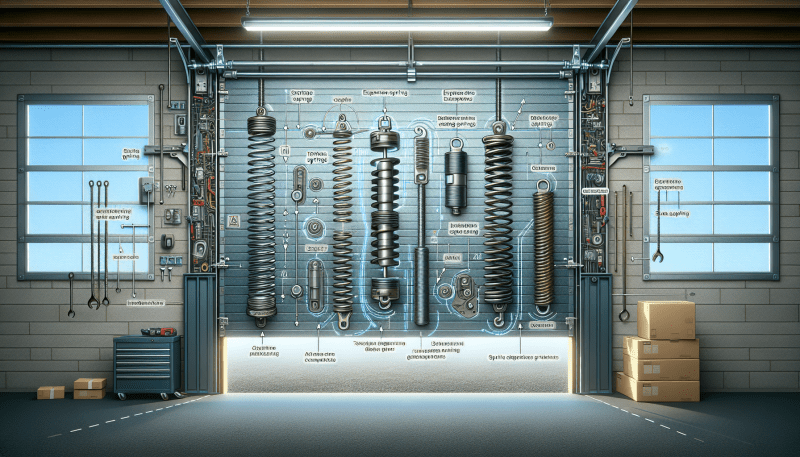**Understanding Garage Door Spring Types and Functions** is essential for any homeowner looking to maintain their garage door effectively. Have you ever wondered why your garage door opens smoothly one day and struggles the next? The answer often lies in the type and condition of the springs that support its operation.
Garage doors typically use two main types of springs: torsion springs and extension springs. Torsion springs are mounted above the door and provide the lifting force, while extension springs are located on either side of the door and stretch to assist in the opening. Understanding these mechanisms can help you identify issues early and ensure your garage door operates safely and efficiently.
But there’s much more to explore beyond just the types of springs. Each spring type has unique functions and maintenance needs that can significantly impact your garage door’s performance. Join us as we delve deeper into the world of garage door springs, guided by industry experts, to ensure your door remains in top shape for years to come.
Overview of Garage Door Springs
Garage door springs are essential components that enable the smooth operation of garage doors. They bear the weight of the door, allowing it to open and close effortlessly. Without these springs, lifting a heavy garage door would be nearly impossible. The two primary types of springs are torsion springs and extension springs. Torsion springs are mounted above the door, while extension springs are located on either side.
When you activate the garage door opener, the springs unwind or stretch, providing the necessary force to lift the door. As the door descends, the springs store energy, ready to assist in the next opening cycle. This mechanism not only ensures functionality but also enhances the longevity of the door system.
Understanding garage door springs is crucial for safety. A malfunctioning spring can lead to accidents or damage. Homeowners should regularly inspect their springs and seek professional help if they notice any issues. For more information on maintenance and repair, visit our FAQ page or explore our services. Always prioritize safety when dealing with garage door components.
Types of Garage Door Springs
Garage doors utilize two primary spring types: torsion springs and extension springs. Torsion springs consist of tightly wound coils that store energy when twisted. They are typically installed above the garage door, providing a balanced lifting mechanism. This design allows for smooth operation and greater durability. However, they can be more expensive to replace and require professional installation. Their strength and longevity often outweigh these drawbacks, making them a popular choice for many homeowners.
On the other hand, extension springs are located on either side of the door. These springs stretch and contract as the door opens and closes. Their simpler design makes them easier to install and replace. However, they may not last as long as torsion springs and can pose safety risks if they break. Despite these concerns, their affordability and straightforward maintenance appeal to many users. For more information on garage door types or to explore frequently asked questions, visit our website. If you need assistance, check out our contact page.
Torsion Springs: In-Depth Analysis
Torsion springs play a crucial role in the operation of garage doors. These springs consist of tightly wound coils that store mechanical energy. When the garage door opens or closes, the torsion spring unwinds or winds, allowing for smooth movement. Typically, torsion springs are mounted above the door, and their design enables them to handle significant weight.
When selecting a torsion spring, consider the size and weight capacity of your garage door. Springs come in various lengths and thicknesses, tailored to different door weights. Choosing the correct spring ensures optimal performance and longevity.
Installing torsion springs requires careful attention to safety. Always wear protective gear, as these springs are under high tension. Essential tools include a winding bar, socket wrench, and safety glasses. Begin by securing the door in the closed position. Next, follow the manufacturer’s guidelines for winding the springs. For detailed guidance, refer to our FAQ section. If you’re unsure about the process, consider consulting our service page for professional assistance. Proper installation is vital for safe and efficient garage door operation.
Extension Springs: In-Depth Analysis
Extension springs play a crucial role in the functionality of garage doors. These springs consist of tightly wound coils that stretch and contract to counterbalance the weight of the door. When the door opens, the springs extend, absorbing energy. Conversely, when the door closes, they contract, providing the necessary force to lower the door smoothly.
Sizes and weight capacities of extension springs vary significantly. Selecting the right spring depends on the garage door’s weight and dimensions. Generally, heavier doors require larger springs with higher tension ratings. It’s essential to consult specifications or a professional to ensure proper selection.
The installation process for extension springs demands careful attention to safety. Begin by gathering necessary tools, including a wrench, safety goggles, and a ladder. Always disconnect the garage door opener before starting. Secure the springs to the door’s track and ensure they are properly aligned. For detailed guidance, refer to our FAQ section. Remember, if you feel uncertain, consider hiring a professional to handle the installation safely.
Common Problems with Garage Door Springs
Garage door springs are essential components that can face several issues over time. Both torsion and extension springs experience wear and tear, leading to potential breakage. Misalignment is another common problem that can occur, affecting the door’s operation. Homeowners should watch for unusual noises, such as squeaking or grinding, which often signal a spring issue. Additionally, if the door moves unevenly or struggles to open and close, these are clear signs of trouble.
Ignoring these problems can lead to serious consequences. For instance, a broken spring can cause the door to fall unexpectedly, posing safety hazards to anyone nearby. Furthermore, delaying repairs can result in more extensive damage, leading to costly repairs. Regular maintenance can help prevent these issues. If you suspect a problem, consider reaching out to professionals for assistance. You can learn more about our services or check our FAQ for more information. Don’t wait until it’s too late; addressing spring issues promptly ensures safety and functionality.
Maintenance Tips for Garage Door Springs
To prolong the life of garage door springs, regular inspections are essential. Check for signs of wear, such as rust or fraying. Additionally, lubricate the springs every few months to reduce friction. Use a silicone-based lubricant for best results. Always ensure the door is closed before performing any maintenance tasks. This precaution helps prevent accidents.
If you notice any unusual noises or if the door operates unevenly, it may be time to call a professional. Attempting repairs without proper knowledge can lead to injury. For complex issues, consider reaching out to experts in garage door spring repair.
Seasonal checks are crucial for optimal performance. Inspect the springs at the beginning of each season to ensure they function correctly. Changes in temperature can affect spring tension, so adjustments may be necessary. Regular maintenance not only enhances safety but also extends the lifespan of your garage door system. For more information on maintenance practices, visit our FAQ page.
Safety Considerations When Dealing with Garage Door Springs
Garage door springs pose significant dangers, particularly during repairs or replacements. These components are under immense tension, and mishandling them can lead to severe injuries. Always prioritize safety by wearing protective gear, such as gloves and goggles. Additionally, ensure that the garage door is fully closed before attempting any work.
When handling springs, use the appropriate tools and follow manufacturer guidelines. Avoid using makeshift tools, as they can increase the risk of accidents. If you lack experience, consider hiring a professional for spring repairs and replacements. Professionals have the training and equipment necessary to perform the job safely.
Moreover, attempting to repair or replace springs without proper knowledge can lead to further damage. This not only increases repair costs but also jeopardizes your safety. For reliable assistance, reach out to experts who specialize in garage door spring repairs. Remember, safety should always come first when dealing with these high-tension components.
Frequently Asked Questions (FAQs)
When it comes to garage door springs, many homeowners have questions. One common inquiry is about the average lifespan of these springs. Typically, garage door springs last between 7 to 14 years, depending on usage and maintenance. Another frequent question is how to identify if springs need replacement. Signs include difficulty opening the door or visible gaps in the springs.
Many wonder if they can replace garage door springs themselves. While some skilled DIY enthusiasts may attempt this, it’s often safer to hire professionals. Additionally, the cost to replace garage door springs varies, but it generally ranges from $200 to $400.
People also ask whether torsion springs are better than extension springs. Torsion springs tend to offer better durability and safety. Choosing the right size spring is crucial; it should match the weight and size of your garage door. Regular maintenance, such as lubrication and inspections, can extend the life of your springs. For more detailed information, visit our FAQ page or explore our blog for tips on garage door care.
Conclusion
In summary, understanding the various types and functions of garage door springs is crucial for every homeowner. Torsion springs and extension springs each serve distinct roles, impacting the door’s operation and safety. Proper maintenance of these components ensures smooth functionality and prevents potential hazards. Moreover, recognizing the signs of wear or malfunction can save you from costly repairs in the long run.
Safety should always be a priority. Garage door springs are under significant tension, making DIY repairs risky. Therefore, it’s wise to seek professional help when issues arise. Experts can provide the necessary garage door spring repair service to ensure your system operates safely and efficiently.
Stay informed about your garage door system. Regular inspections and maintenance can prolong the lifespan of your springs. For more information on garage door services, visit our about page or check our FAQ section for common questions. Prioritize safety and knowledge to keep your garage door in optimal condition.






